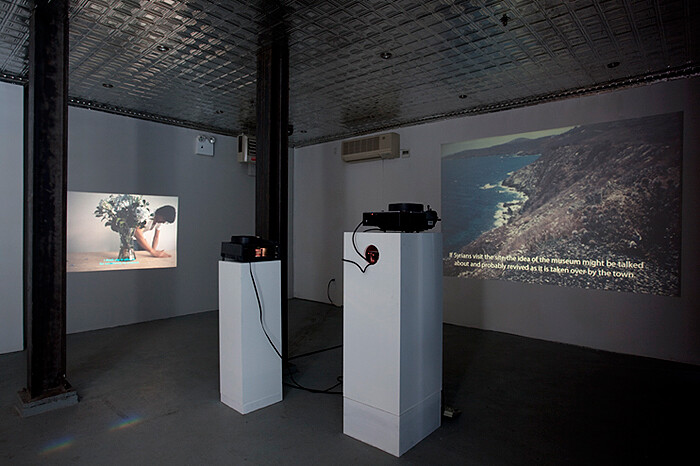The Lower East Side is a strange place. Imagine the area a mere three years ago: as the financial crisis loomed, galleries such as Invisible-Exports, Lisa Cooley and Rachel Uffner joined or replaced the efforts of veteran spaces Orchard, CANADA, and Reena Spaulings, casting the gallery district as a more critically-minded alternative to the overtly market-driven slickness of Chelsea. Soon after, as real estate prices fell further and the traction of Orchard Street grew, near-hobbyist boutique galleries popped up and faded, transforming the area into a sort of strip mall for affordable art. One usually vacant space on Orchard Street—which used to house a gallery whose title was writ in Comic Sans and sold National Geographic-style photographs of tigers and elephants—recently contained the pop-up exhibition “Cover Letter” by conceptual artist Mario Garcia Torres. Appropriately titled “Itinerant,” the exhibition project is spearheaded by two blue-chip gallery directors, Rose Lord of Marian Goodman and Mari Spirito of 303 Gallery.
“Cover Letter” comprises two slide projections: a new work sharing the exhibition’s title and an older work, What Doesn’t Kill You Makes You Stronger, from 2007. The series of slides in Cover Letter tracks Garcia Torres assembling a bouquet while a letter of application to become the director of the Kunsthalle Bern subscripts the picture plane. The artist comes off as somewhat poetic and entirely sincere, “I have persistently thought about…the meanings and political implications behind the ways art is produced and exhibited. I deem this the fundamental knowledge needed to run an institution like the Kunsthalle Bern.”
Rather than send the search committee a real bouquet of flowers, Garcia Torres says, he is sending it in the form of these slides. And what of the bouquet? The contradistinction between the bourgeois, leisure-steeped symbol of the floral bouquet with the strange, when-pigs-fly sentiment of a young Mexican artist applying for a director’s position at a major cultural institution brings to mind unfortunate hierarchies of labor and authority in the art world, and specifically the tragically invisible labor permeating both it and the highly corrupt floral industry. Perhaps directly referent, such an analogy was actually made decades before in Martha Rosler’s 1974 Flower Fields in which illegal Mexican day laborers working in the flower fields along California’s Highway 5 were filmed from a car window.
Perhaps more straightforward is Garcia Torres’s What Doesn’t Kill You Makes You Stronger, a slide presentation about the mythology surrounding Martin Kippenberger’s short-lived Museum of Modern Art on the Greek island Syros. Kippenberger initiated the project in 1993, taking over the skeleton-like building by inviting a gaggle of international artists to stage events, including Stephen Prina, Cosima von Bonin, and Christopher Williams. Their exploits were generally ignored by tourists and Syros locals, and the project was abandoned after Kippenberger’s death from liver cancer four years later in 1997. The building now somewhat ironically processes human excrement.
Although the slide projections presented here may prove fascinating to those with a penchant for curiosities in art history (myself included), they collapse under their contextual insensitivity and lack of perspicacity. Why present a slide projection in 2011 if the obsolescence of that technology is nary considered? Can this format still prove relevant to shedding insight on the contemporary condition of the artist, or does it just symbol a form of retro-aesthetic posturing? How is it possible that institutional critique has become resolutely a-political? Perhaps such contemporary manifestations of institutional critique seem ultimately empty in the hermetic art world agora that is now the Lower East Side.




